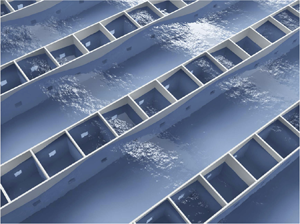Article contents
Negative refraction of water waves by hyperbolic metamaterials
Published online by Cambridge University Press: 19 April 2023
Abstract

We study the propagation of water waves in a three-dimensional device alternating open canals and resonant canals with subwavelength resonances. The dispersion of water waves in such a medium is obtained by analysing the full three-dimensional problem and combining Bloch–Floquet analysis with an asymptotic technique. We obtain the closed forms of the dispersions for resonant canals containing one or two resonators, which depend on only two functions associated with symmetric and antisymmetric modes, and on a geometric parameter analogous to the hopping parameter in topological systems. The analysis of the complete band structure reveals frequency ranges alternating between elliptical and hyperbolic dispersions; in particular, the hyperbolic regime gives rise to a negative effective water depth with a consequent negative refraction. Throughout the course of our study, our theoretical results are validated by comparison with numerical calculations of the full three-dimensional problem.
JFM classification
- Type
- JFM Papers
- Information
- Copyright
- © The Author(s), 2023. Published by Cambridge University Press
References
- 5
- Cited by



